Analysis of Deficit Irrigation and Water Use Efficiency
VerifiedAdded on 2023/04/20
|11
|2884
|262
Report
AI Summary
This report provides a comprehensive overview of deficit irrigation, a water management technique aimed at increasing water efficiency in agriculture. It begins by highlighting the global water scarcity problem and the increasing need for sustainable irrigation practices. The report explores the concept of deficit irrigation, its application strategies, and its impact on crop water requirements. It delves into the physiological responses of plants to water stress, including evapotranspiration and stomatal behavior, and how these factors influence irrigation planning. The report reviews the literature on crop water needs, the influence of climate, and the importance of understanding crop sensitivity to drought. It discusses the benefits of deficit irrigation, such as improved water use efficiency and reduced irrigation costs, while also acknowledging the potential for yield reductions in some crops. The report also examines the role of deficit irrigation in specific crops, such as winter wheat, cotton, and quinoa, and its application in viticulture and fruit tree development. The report concludes by emphasizing the potential of deficit irrigation to address water scarcity and promote sustainable agricultural practices.
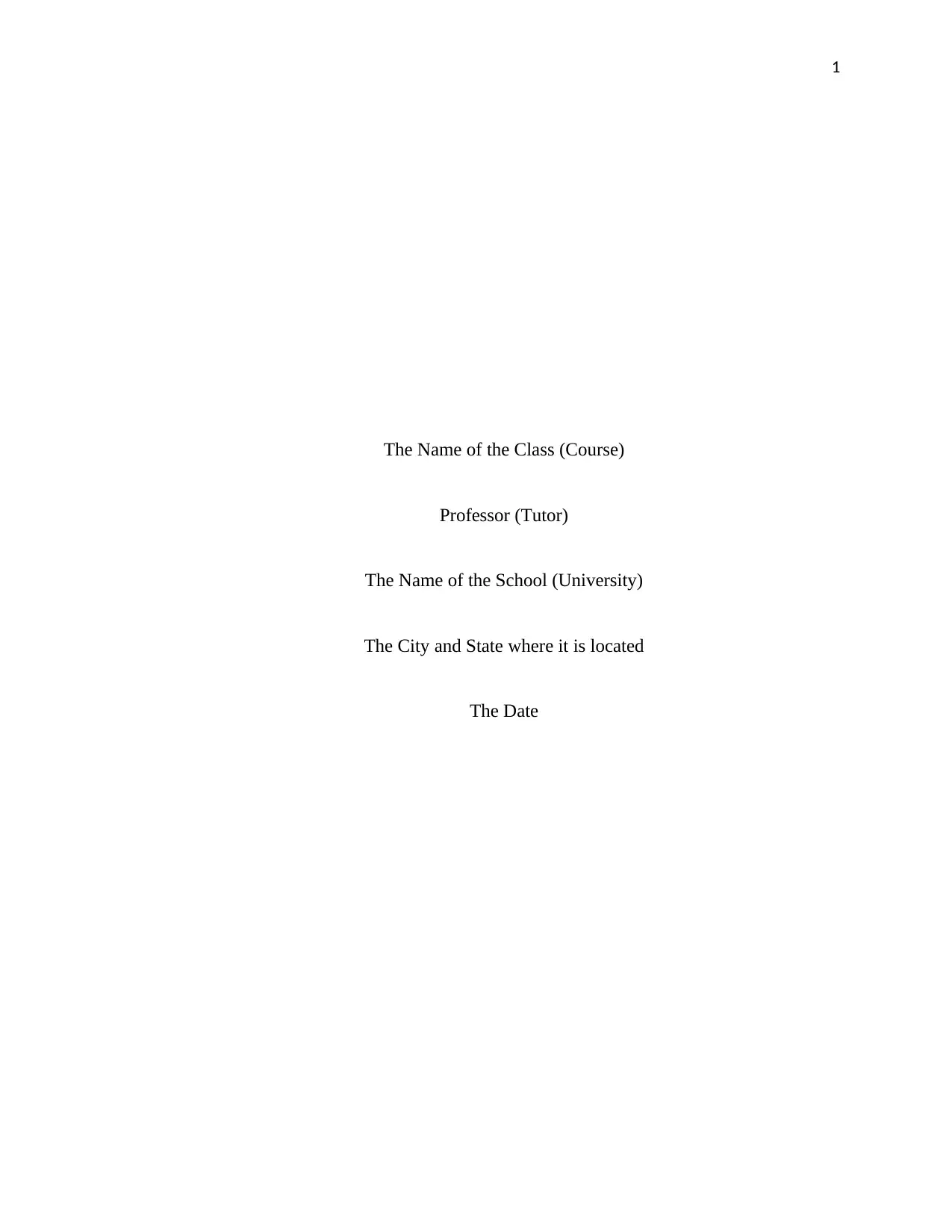
1
The Name of the Class (Course)
Professor (Tutor)
The Name of the School (University)
The City and State where it is located
The Date
The Name of the Class (Course)
Professor (Tutor)
The Name of the School (University)
The City and State where it is located
The Date
Paraphrase This Document
Need a fresh take? Get an instant paraphrase of this document with our AI Paraphraser
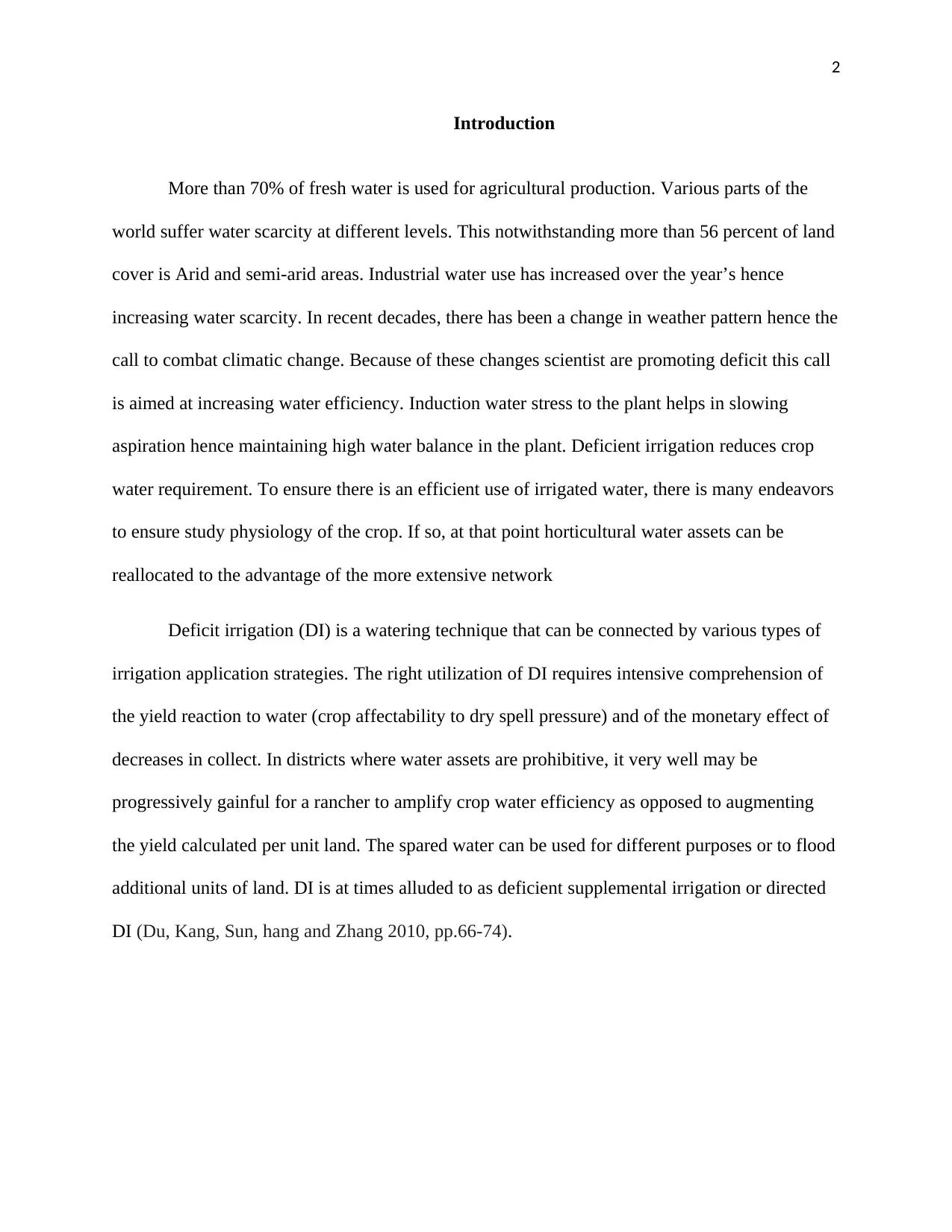
2
Introduction
More than 70% of fresh water is used for agricultural production. Various parts of the
world suffer water scarcity at different levels. This notwithstanding more than 56 percent of land
cover is Arid and semi-arid areas. Industrial water use has increased over the year’s hence
increasing water scarcity. In recent decades, there has been a change in weather pattern hence the
call to combat climatic change. Because of these changes scientist are promoting deficit this call
is aimed at increasing water efficiency. Induction water stress to the plant helps in slowing
aspiration hence maintaining high water balance in the plant. Deficient irrigation reduces crop
water requirement. To ensure there is an efficient use of irrigated water, there is many endeavors
to ensure study physiology of the crop. If so, at that point horticultural water assets can be
reallocated to the advantage of the more extensive network
Deficit irrigation (DI) is a watering technique that can be connected by various types of
irrigation application strategies. The right utilization of DI requires intensive comprehension of
the yield reaction to water (crop affectability to dry spell pressure) and of the monetary effect of
decreases in collect. In districts where water assets are prohibitive, it very well may be
progressively gainful for a rancher to amplify crop water efficiency as opposed to augmenting
the yield calculated per unit land. The spared water can be used for different purposes or to flood
additional units of land. DI is at times alluded to as deficient supplemental irrigation or directed
DI (Du, Kang, Sun, hang and Zhang 2010, pp.66-74).
Introduction
More than 70% of fresh water is used for agricultural production. Various parts of the
world suffer water scarcity at different levels. This notwithstanding more than 56 percent of land
cover is Arid and semi-arid areas. Industrial water use has increased over the year’s hence
increasing water scarcity. In recent decades, there has been a change in weather pattern hence the
call to combat climatic change. Because of these changes scientist are promoting deficit this call
is aimed at increasing water efficiency. Induction water stress to the plant helps in slowing
aspiration hence maintaining high water balance in the plant. Deficient irrigation reduces crop
water requirement. To ensure there is an efficient use of irrigated water, there is many endeavors
to ensure study physiology of the crop. If so, at that point horticultural water assets can be
reallocated to the advantage of the more extensive network
Deficit irrigation (DI) is a watering technique that can be connected by various types of
irrigation application strategies. The right utilization of DI requires intensive comprehension of
the yield reaction to water (crop affectability to dry spell pressure) and of the monetary effect of
decreases in collect. In districts where water assets are prohibitive, it very well may be
progressively gainful for a rancher to amplify crop water efficiency as opposed to augmenting
the yield calculated per unit land. The spared water can be used for different purposes or to flood
additional units of land. DI is at times alluded to as deficient supplemental irrigation or directed
DI (Du, Kang, Sun, hang and Zhang 2010, pp.66-74).
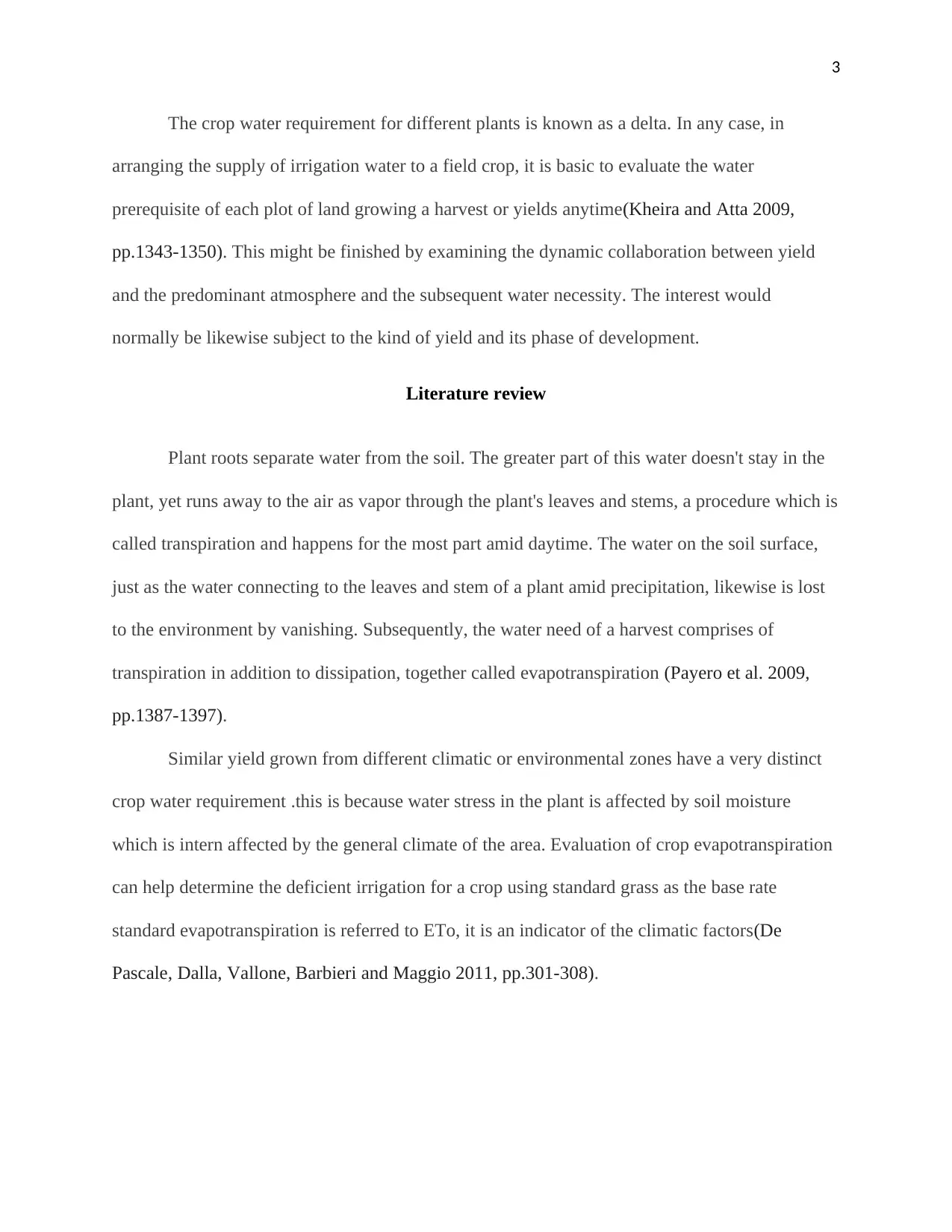
3
The crop water requirement for different plants is known as a delta. In any case, in
arranging the supply of irrigation water to a field crop, it is basic to evaluate the water
prerequisite of each plot of land growing a harvest or yields anytime(Kheira and Atta 2009,
pp.1343-1350). This might be finished by examining the dynamic collaboration between yield
and the predominant atmosphere and the subsequent water necessity. The interest would
normally be likewise subject to the kind of yield and its phase of development.
Literature review
Plant roots separate water from the soil. The greater part of this water doesn't stay in the
plant, yet runs away to the air as vapor through the plant's leaves and stems, a procedure which is
called transpiration and happens for the most part amid daytime. The water on the soil surface,
just as the water connecting to the leaves and stem of a plant amid precipitation, likewise is lost
to the environment by vanishing. Subsequently, the water need of a harvest comprises of
transpiration in addition to dissipation, together called evapotranspiration (Payero et al. 2009,
pp.1387-1397).
Similar yield grown from different climatic or environmental zones have a very distinct
crop water requirement .this is because water stress in the plant is affected by soil moisture
which is intern affected by the general climate of the area. Evaluation of crop evapotranspiration
can help determine the deficient irrigation for a crop using standard grass as the base rate
standard evapotranspiration is referred to ETo, it is an indicator of the climatic factors(De
Pascale, Dalla, Vallone, Barbieri and Maggio 2011, pp.301-308).
The crop water requirement for different plants is known as a delta. In any case, in
arranging the supply of irrigation water to a field crop, it is basic to evaluate the water
prerequisite of each plot of land growing a harvest or yields anytime(Kheira and Atta 2009,
pp.1343-1350). This might be finished by examining the dynamic collaboration between yield
and the predominant atmosphere and the subsequent water necessity. The interest would
normally be likewise subject to the kind of yield and its phase of development.
Literature review
Plant roots separate water from the soil. The greater part of this water doesn't stay in the
plant, yet runs away to the air as vapor through the plant's leaves and stems, a procedure which is
called transpiration and happens for the most part amid daytime. The water on the soil surface,
just as the water connecting to the leaves and stem of a plant amid precipitation, likewise is lost
to the environment by vanishing. Subsequently, the water need of a harvest comprises of
transpiration in addition to dissipation, together called evapotranspiration (Payero et al. 2009,
pp.1387-1397).
Similar yield grown from different climatic or environmental zones have a very distinct
crop water requirement .this is because water stress in the plant is affected by soil moisture
which is intern affected by the general climate of the area. Evaluation of crop evapotranspiration
can help determine the deficient irrigation for a crop using standard grass as the base rate
standard evapotranspiration is referred to ETo, it is an indicator of the climatic factors(De
Pascale, Dalla, Vallone, Barbieri and Maggio 2011, pp.301-308).
⊘ This is a preview!⊘
Do you want full access?
Subscribe today to unlock all pages.

Trusted by 1+ million students worldwide
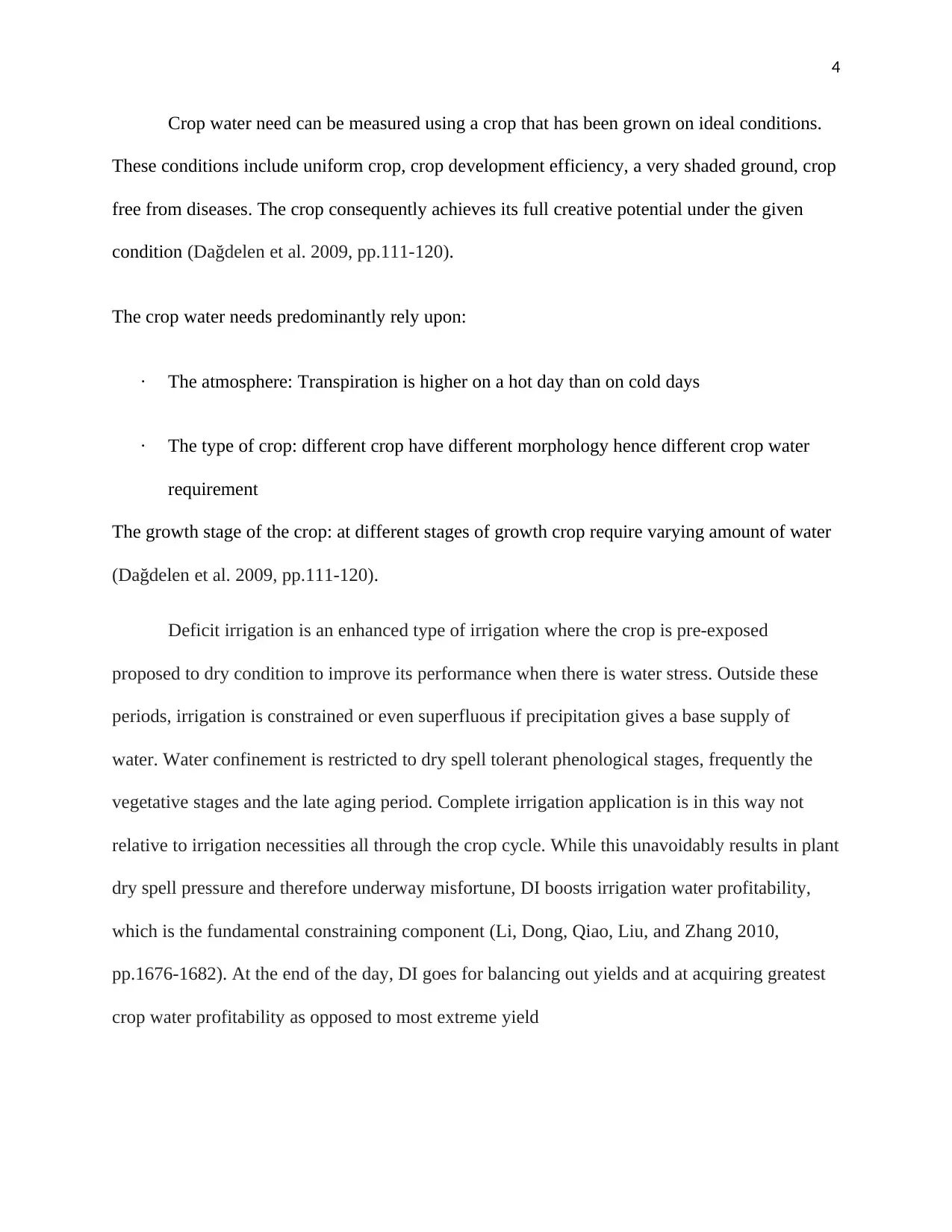
4
Crop water need can be measured using a crop that has been grown on ideal conditions.
These conditions include uniform crop, crop development efficiency, a very shaded ground, crop
free from diseases. The crop consequently achieves its full creative potential under the given
condition (Dağdelen et al. 2009, pp.111-120).
The crop water needs predominantly rely upon:
· The atmosphere: Transpiration is higher on a hot day than on cold days
· The type of crop: different crop have different morphology hence different crop water
requirement
The growth stage of the crop: at different stages of growth crop require varying amount of water
(Dağdelen et al. 2009, pp.111-120).
Deficit irrigation is an enhanced type of irrigation where the crop is pre-exposed
proposed to dry condition to improve its performance when there is water stress. Outside these
periods, irrigation is constrained or even superfluous if precipitation gives a base supply of
water. Water confinement is restricted to dry spell tolerant phenological stages, frequently the
vegetative stages and the late aging period. Complete irrigation application is in this way not
relative to irrigation necessities all through the crop cycle. While this unavoidably results in plant
dry spell pressure and therefore underway misfortune, DI boosts irrigation water profitability,
which is the fundamental constraining component (Li, Dong, Qiao, Liu, and Zhang 2010,
pp.1676-1682). At the end of the day, DI goes for balancing out yields and at acquiring greatest
crop water profitability as opposed to most extreme yield
Crop water need can be measured using a crop that has been grown on ideal conditions.
These conditions include uniform crop, crop development efficiency, a very shaded ground, crop
free from diseases. The crop consequently achieves its full creative potential under the given
condition (Dağdelen et al. 2009, pp.111-120).
The crop water needs predominantly rely upon:
· The atmosphere: Transpiration is higher on a hot day than on cold days
· The type of crop: different crop have different morphology hence different crop water
requirement
The growth stage of the crop: at different stages of growth crop require varying amount of water
(Dağdelen et al. 2009, pp.111-120).
Deficit irrigation is an enhanced type of irrigation where the crop is pre-exposed
proposed to dry condition to improve its performance when there is water stress. Outside these
periods, irrigation is constrained or even superfluous if precipitation gives a base supply of
water. Water confinement is restricted to dry spell tolerant phenological stages, frequently the
vegetative stages and the late aging period. Complete irrigation application is in this way not
relative to irrigation necessities all through the crop cycle. While this unavoidably results in plant
dry spell pressure and therefore underway misfortune, DI boosts irrigation water profitability,
which is the fundamental constraining component (Li, Dong, Qiao, Liu, and Zhang 2010,
pp.1676-1682). At the end of the day, DI goes for balancing out yields and at acquiring greatest
crop water profitability as opposed to most extreme yield
Paraphrase This Document
Need a fresh take? Get an instant paraphrase of this document with our AI Paraphraser
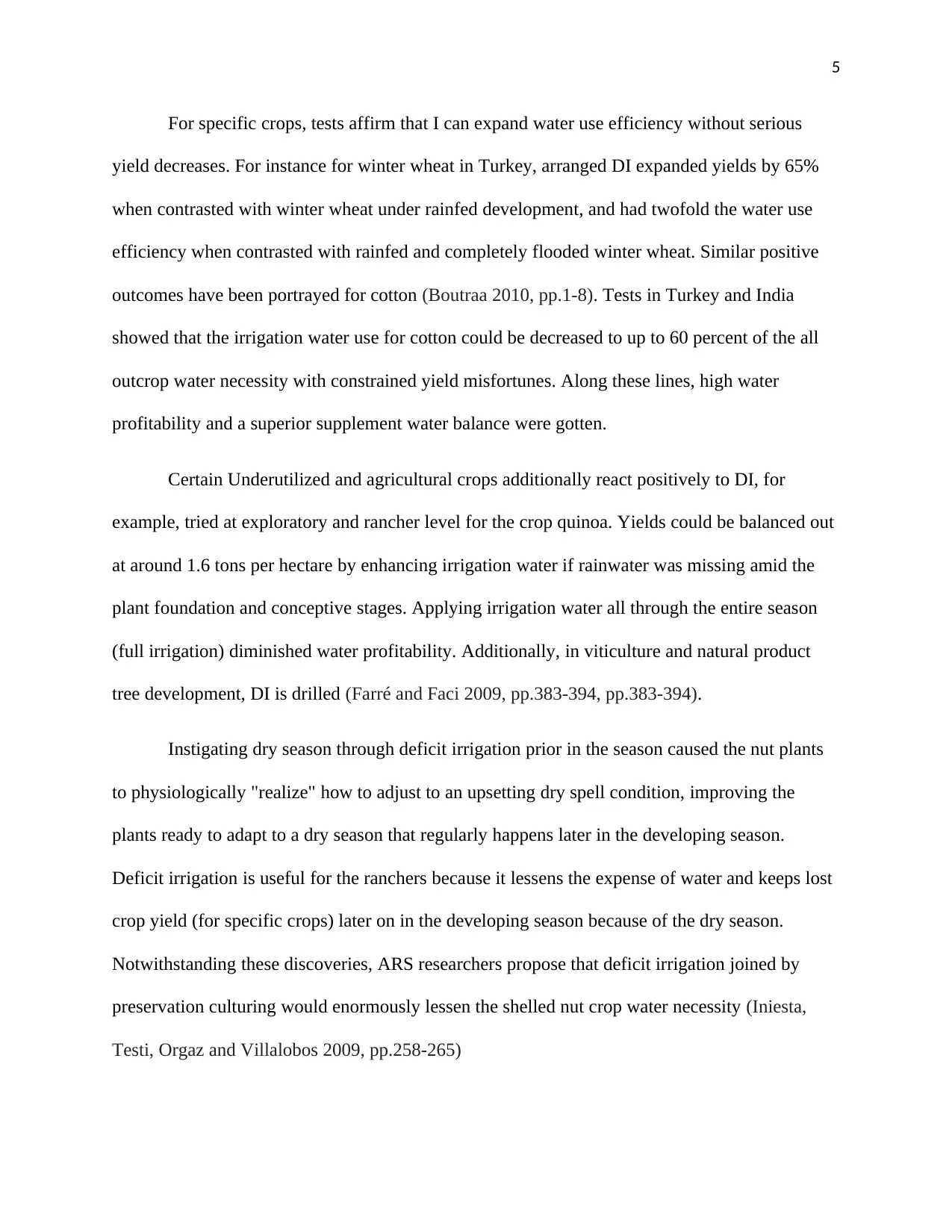
5
For specific crops, tests affirm that I can expand water use efficiency without serious
yield decreases. For instance for winter wheat in Turkey, arranged DI expanded yields by 65%
when contrasted with winter wheat under rainfed development, and had twofold the water use
efficiency when contrasted with rainfed and completely flooded winter wheat. Similar positive
outcomes have been portrayed for cotton (Boutraa 2010, pp.1-8). Tests in Turkey and India
showed that the irrigation water use for cotton could be decreased to up to 60 percent of the all
outcrop water necessity with constrained yield misfortunes. Along these lines, high water
profitability and a superior supplement water balance were gotten.
Certain Underutilized and agricultural crops additionally react positively to DI, for
example, tried at exploratory and rancher level for the crop quinoa. Yields could be balanced out
at around 1.6 tons per hectare by enhancing irrigation water if rainwater was missing amid the
plant foundation and conceptive stages. Applying irrigation water all through the entire season
(full irrigation) diminished water profitability. Additionally, in viticulture and natural product
tree development, DI is drilled (Farré and Faci 2009, pp.383-394, pp.383-394).
Instigating dry season through deficit irrigation prior in the season caused the nut plants
to physiologically "realize" how to adjust to an upsetting dry spell condition, improving the
plants ready to adapt to a dry season that regularly happens later in the developing season.
Deficit irrigation is useful for the ranchers because it lessens the expense of water and keeps lost
crop yield (for specific crops) later on in the developing season because of the dry season.
Notwithstanding these discoveries, ARS researchers propose that deficit irrigation joined by
preservation culturing would enormously lessen the shelled nut crop water necessity (Iniesta,
Testi, Orgaz and Villalobos 2009, pp.258-265)
For specific crops, tests affirm that I can expand water use efficiency without serious
yield decreases. For instance for winter wheat in Turkey, arranged DI expanded yields by 65%
when contrasted with winter wheat under rainfed development, and had twofold the water use
efficiency when contrasted with rainfed and completely flooded winter wheat. Similar positive
outcomes have been portrayed for cotton (Boutraa 2010, pp.1-8). Tests in Turkey and India
showed that the irrigation water use for cotton could be decreased to up to 60 percent of the all
outcrop water necessity with constrained yield misfortunes. Along these lines, high water
profitability and a superior supplement water balance were gotten.
Certain Underutilized and agricultural crops additionally react positively to DI, for
example, tried at exploratory and rancher level for the crop quinoa. Yields could be balanced out
at around 1.6 tons per hectare by enhancing irrigation water if rainwater was missing amid the
plant foundation and conceptive stages. Applying irrigation water all through the entire season
(full irrigation) diminished water profitability. Additionally, in viticulture and natural product
tree development, DI is drilled (Farré and Faci 2009, pp.383-394, pp.383-394).
Instigating dry season through deficit irrigation prior in the season caused the nut plants
to physiologically "realize" how to adjust to an upsetting dry spell condition, improving the
plants ready to adapt to a dry season that regularly happens later in the developing season.
Deficit irrigation is useful for the ranchers because it lessens the expense of water and keeps lost
crop yield (for specific crops) later on in the developing season because of the dry season.
Notwithstanding these discoveries, ARS researchers propose that deficit irrigation joined by
preservation culturing would enormously lessen the shelled nut crop water necessity (Iniesta,
Testi, Orgaz and Villalobos 2009, pp.258-265)
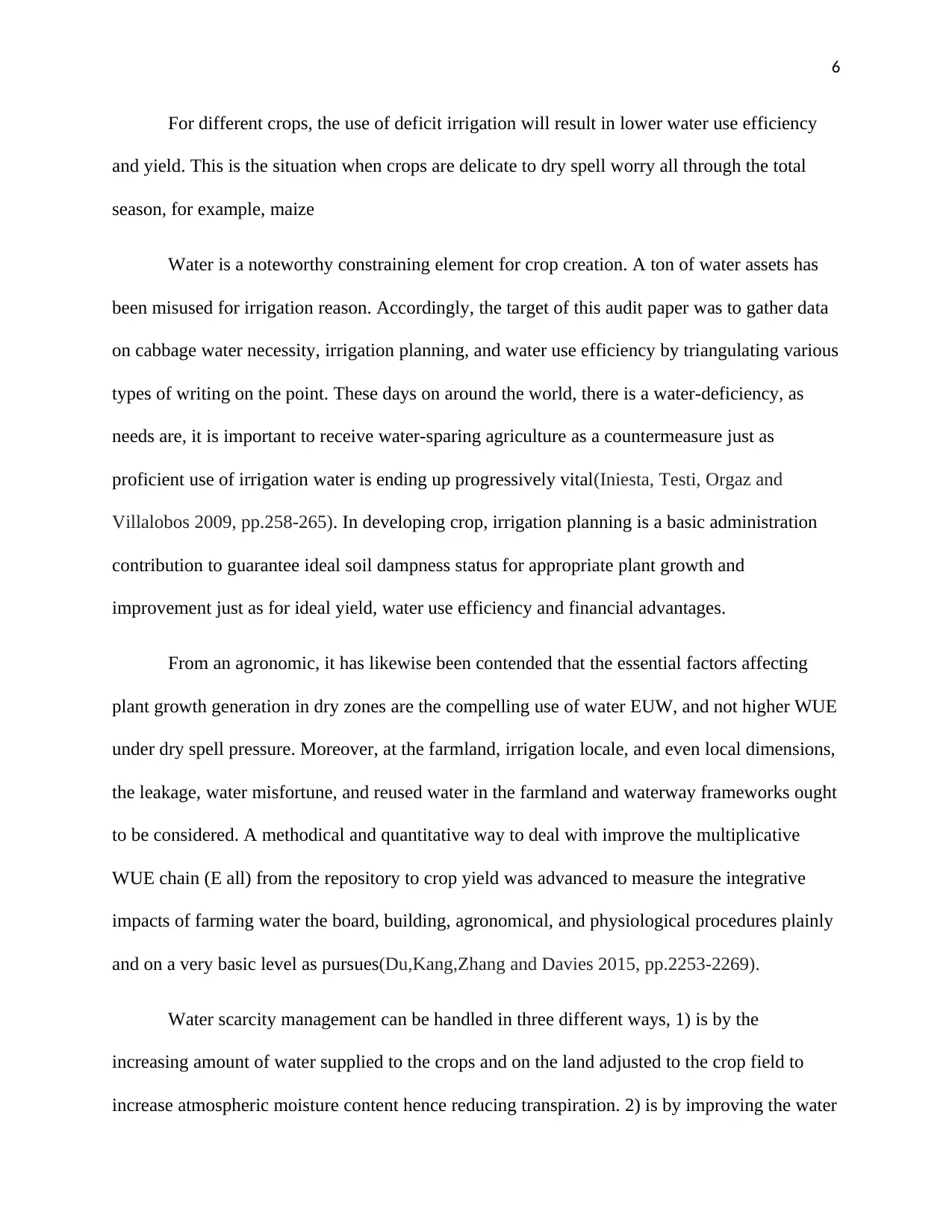
6
For different crops, the use of deficit irrigation will result in lower water use efficiency
and yield. This is the situation when crops are delicate to dry spell worry all through the total
season, for example, maize
Water is a noteworthy constraining element for crop creation. A ton of water assets has
been misused for irrigation reason. Accordingly, the target of this audit paper was to gather data
on cabbage water necessity, irrigation planning, and water use efficiency by triangulating various
types of writing on the point. These days on around the world, there is a water-deficiency, as
needs are, it is important to receive water-sparing agriculture as a countermeasure just as
proficient use of irrigation water is ending up progressively vital(Iniesta, Testi, Orgaz and
Villalobos 2009, pp.258-265). In developing crop, irrigation planning is a basic administration
contribution to guarantee ideal soil dampness status for appropriate plant growth and
improvement just as for ideal yield, water use efficiency and financial advantages.
From an agronomic, it has likewise been contended that the essential factors affecting
plant growth generation in dry zones are the compelling use of water EUW, and not higher WUE
under dry spell pressure. Moreover, at the farmland, irrigation locale, and even local dimensions,
the leakage, water misfortune, and reused water in the farmland and waterway frameworks ought
to be considered. A methodical and quantitative way to deal with improve the multiplicative
WUE chain (E all) from the repository to crop yield was advanced to measure the integrative
impacts of farming water the board, building, agronomical, and physiological procedures plainly
and on a very basic level as pursues(Du,Kang,Zhang and Davies 2015, pp.2253-2269).
Water scarcity management can be handled in three different ways, 1) is by the
increasing amount of water supplied to the crops and on the land adjusted to the crop field to
increase atmospheric moisture content hence reducing transpiration. 2) is by improving the water
For different crops, the use of deficit irrigation will result in lower water use efficiency
and yield. This is the situation when crops are delicate to dry spell worry all through the total
season, for example, maize
Water is a noteworthy constraining element for crop creation. A ton of water assets has
been misused for irrigation reason. Accordingly, the target of this audit paper was to gather data
on cabbage water necessity, irrigation planning, and water use efficiency by triangulating various
types of writing on the point. These days on around the world, there is a water-deficiency, as
needs are, it is important to receive water-sparing agriculture as a countermeasure just as
proficient use of irrigation water is ending up progressively vital(Iniesta, Testi, Orgaz and
Villalobos 2009, pp.258-265). In developing crop, irrigation planning is a basic administration
contribution to guarantee ideal soil dampness status for appropriate plant growth and
improvement just as for ideal yield, water use efficiency and financial advantages.
From an agronomic, it has likewise been contended that the essential factors affecting
plant growth generation in dry zones are the compelling use of water EUW, and not higher WUE
under dry spell pressure. Moreover, at the farmland, irrigation locale, and even local dimensions,
the leakage, water misfortune, and reused water in the farmland and waterway frameworks ought
to be considered. A methodical and quantitative way to deal with improve the multiplicative
WUE chain (E all) from the repository to crop yield was advanced to measure the integrative
impacts of farming water the board, building, agronomical, and physiological procedures plainly
and on a very basic level as pursues(Du,Kang,Zhang and Davies 2015, pp.2253-2269).
Water scarcity management can be handled in three different ways, 1) is by the
increasing amount of water supplied to the crops and on the land adjusted to the crop field to
increase atmospheric moisture content hence reducing transpiration. 2) is by improving the water
⊘ This is a preview!⊘
Do you want full access?
Subscribe today to unlock all pages.

Trusted by 1+ million students worldwide
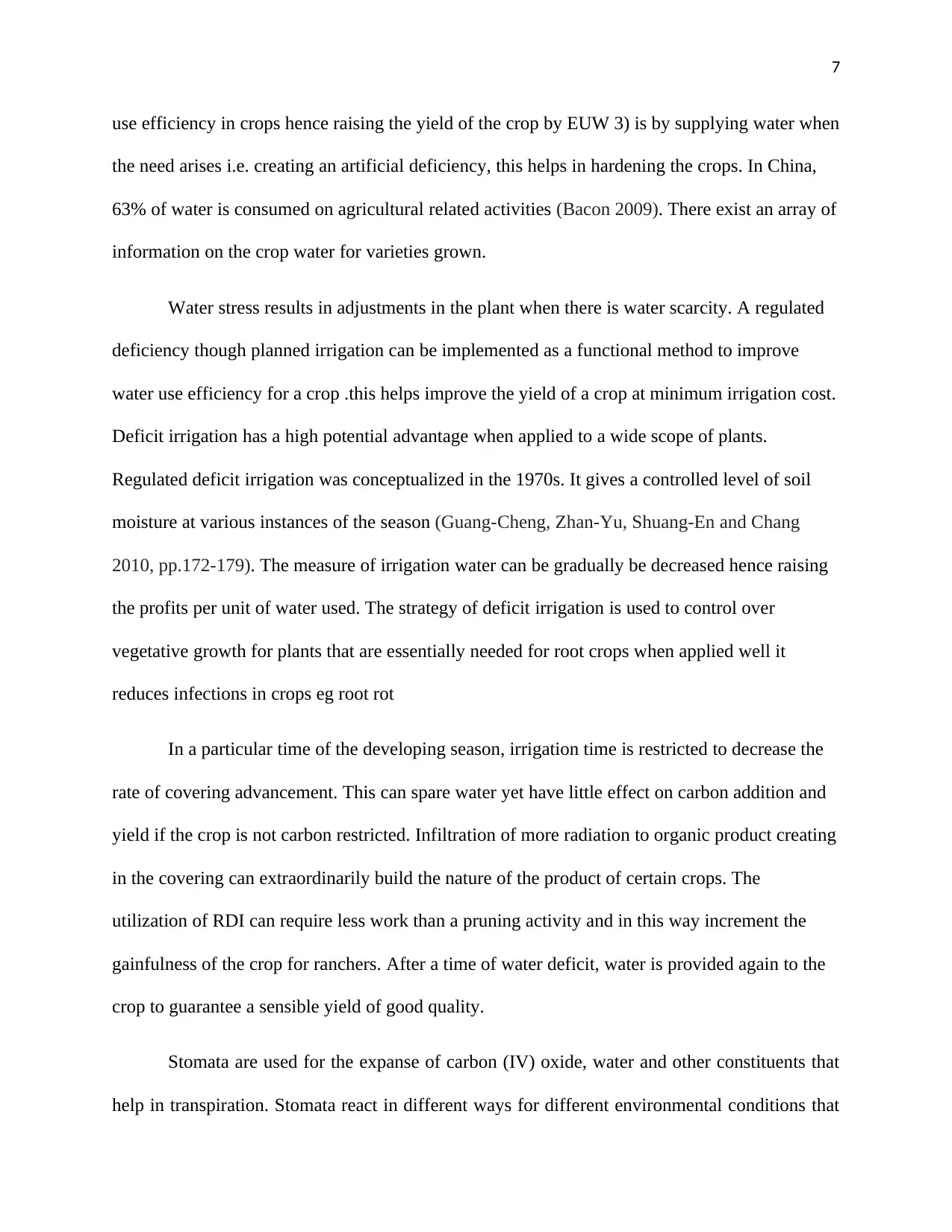
7
use efficiency in crops hence raising the yield of the crop by EUW 3) is by supplying water when
the need arises i.e. creating an artificial deficiency, this helps in hardening the crops. In China,
63% of water is consumed on agricultural related activities (Bacon 2009). There exist an array of
information on the crop water for varieties grown.
Water stress results in adjustments in the plant when there is water scarcity. A regulated
deficiency though planned irrigation can be implemented as a functional method to improve
water use efficiency for a crop .this helps improve the yield of a crop at minimum irrigation cost.
Deficit irrigation has a high potential advantage when applied to a wide scope of plants.
Regulated deficit irrigation was conceptualized in the 1970s. It gives a controlled level of soil
moisture at various instances of the season (Guang-Cheng, Zhan-Yu, Shuang-En and Chang
2010, pp.172-179). The measure of irrigation water can be gradually be decreased hence raising
the profits per unit of water used. The strategy of deficit irrigation is used to control over
vegetative growth for plants that are essentially needed for root crops when applied well it
reduces infections in crops eg root rot
In a particular time of the developing season, irrigation time is restricted to decrease the
rate of covering advancement. This can spare water yet have little effect on carbon addition and
yield if the crop is not carbon restricted. Infiltration of more radiation to organic product creating
in the covering can extraordinarily build the nature of the product of certain crops. The
utilization of RDI can require less work than a pruning activity and in this way increment the
gainfulness of the crop for ranchers. After a time of water deficit, water is provided again to the
crop to guarantee a sensible yield of good quality.
Stomata are used for the expanse of carbon (IV) oxide, water and other constituents that
help in transpiration. Stomata react in different ways for different environmental conditions that
use efficiency in crops hence raising the yield of the crop by EUW 3) is by supplying water when
the need arises i.e. creating an artificial deficiency, this helps in hardening the crops. In China,
63% of water is consumed on agricultural related activities (Bacon 2009). There exist an array of
information on the crop water for varieties grown.
Water stress results in adjustments in the plant when there is water scarcity. A regulated
deficiency though planned irrigation can be implemented as a functional method to improve
water use efficiency for a crop .this helps improve the yield of a crop at minimum irrigation cost.
Deficit irrigation has a high potential advantage when applied to a wide scope of plants.
Regulated deficit irrigation was conceptualized in the 1970s. It gives a controlled level of soil
moisture at various instances of the season (Guang-Cheng, Zhan-Yu, Shuang-En and Chang
2010, pp.172-179). The measure of irrigation water can be gradually be decreased hence raising
the profits per unit of water used. The strategy of deficit irrigation is used to control over
vegetative growth for plants that are essentially needed for root crops when applied well it
reduces infections in crops eg root rot
In a particular time of the developing season, irrigation time is restricted to decrease the
rate of covering advancement. This can spare water yet have little effect on carbon addition and
yield if the crop is not carbon restricted. Infiltration of more radiation to organic product creating
in the covering can extraordinarily build the nature of the product of certain crops. The
utilization of RDI can require less work than a pruning activity and in this way increment the
gainfulness of the crop for ranchers. After a time of water deficit, water is provided again to the
crop to guarantee a sensible yield of good quality.
Stomata are used for the expanse of carbon (IV) oxide, water and other constituents that
help in transpiration. Stomata react in different ways for different environmental conditions that
Paraphrase This Document
Need a fresh take? Get an instant paraphrase of this document with our AI Paraphraser
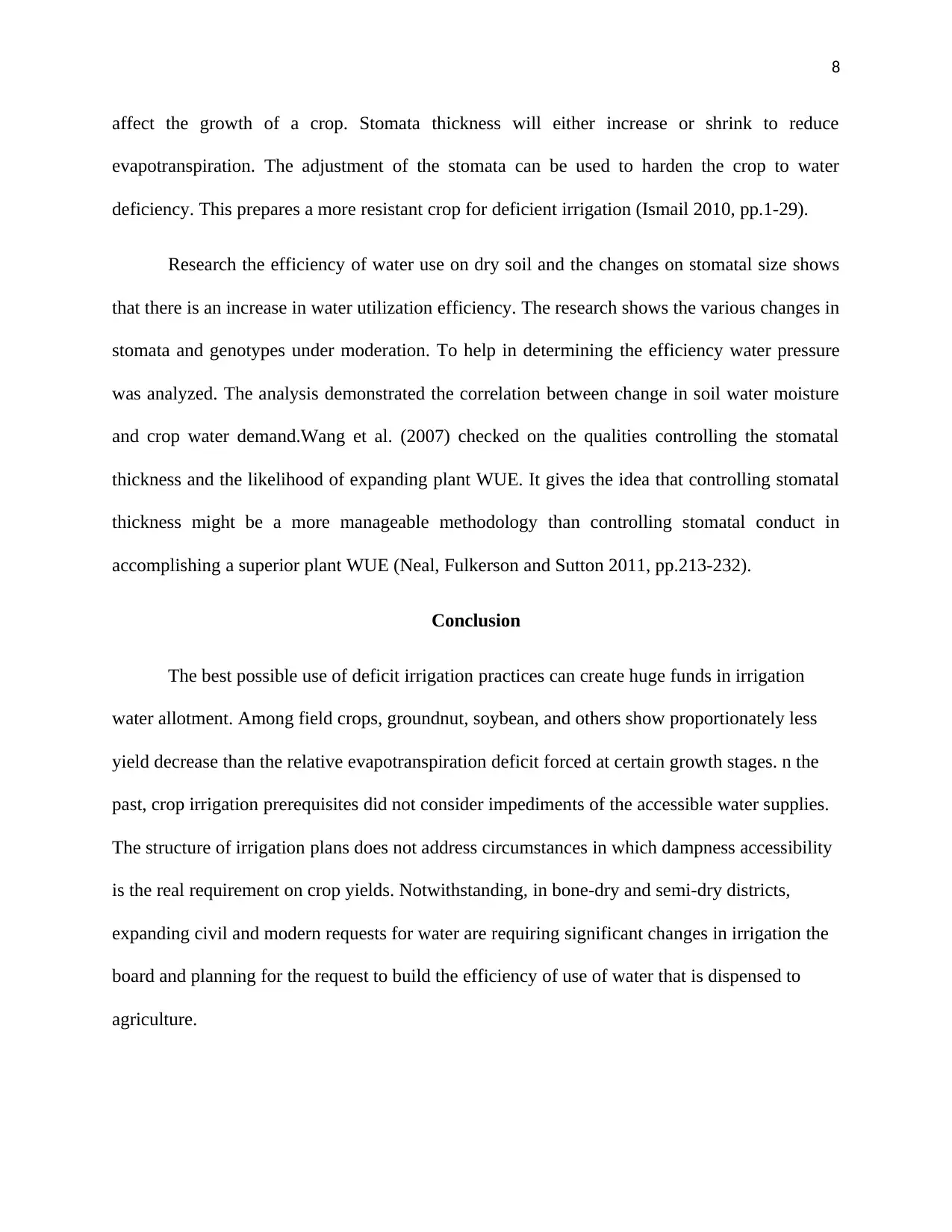
8
affect the growth of a crop. Stomata thickness will either increase or shrink to reduce
evapotranspiration. The adjustment of the stomata can be used to harden the crop to water
deficiency. This prepares a more resistant crop for deficient irrigation (Ismail 2010, pp.1-29).
Research the efficiency of water use on dry soil and the changes on stomatal size shows
that there is an increase in water utilization efficiency. The research shows the various changes in
stomata and genotypes under moderation. To help in determining the efficiency water pressure
was analyzed. The analysis demonstrated the correlation between change in soil water moisture
and crop water demand.Wang et al. (2007) checked on the qualities controlling the stomatal
thickness and the likelihood of expanding plant WUE. It gives the idea that controlling stomatal
thickness might be a more manageable methodology than controlling stomatal conduct in
accomplishing a superior plant WUE (Neal, Fulkerson and Sutton 2011, pp.213-232).
Conclusion
The best possible use of deficit irrigation practices can create huge funds in irrigation
water allotment. Among field crops, groundnut, soybean, and others show proportionately less
yield decrease than the relative evapotranspiration deficit forced at certain growth stages. n the
past, crop irrigation prerequisites did not consider impediments of the accessible water supplies.
The structure of irrigation plans does not address circumstances in which dampness accessibility
is the real requirement on crop yields. Notwithstanding, in bone-dry and semi-dry districts,
expanding civil and modern requests for water are requiring significant changes in irrigation the
board and planning for the request to build the efficiency of use of water that is dispensed to
agriculture.
affect the growth of a crop. Stomata thickness will either increase or shrink to reduce
evapotranspiration. The adjustment of the stomata can be used to harden the crop to water
deficiency. This prepares a more resistant crop for deficient irrigation (Ismail 2010, pp.1-29).
Research the efficiency of water use on dry soil and the changes on stomatal size shows
that there is an increase in water utilization efficiency. The research shows the various changes in
stomata and genotypes under moderation. To help in determining the efficiency water pressure
was analyzed. The analysis demonstrated the correlation between change in soil water moisture
and crop water demand.Wang et al. (2007) checked on the qualities controlling the stomatal
thickness and the likelihood of expanding plant WUE. It gives the idea that controlling stomatal
thickness might be a more manageable methodology than controlling stomatal conduct in
accomplishing a superior plant WUE (Neal, Fulkerson and Sutton 2011, pp.213-232).
Conclusion
The best possible use of deficit irrigation practices can create huge funds in irrigation
water allotment. Among field crops, groundnut, soybean, and others show proportionately less
yield decrease than the relative evapotranspiration deficit forced at certain growth stages. n the
past, crop irrigation prerequisites did not consider impediments of the accessible water supplies.
The structure of irrigation plans does not address circumstances in which dampness accessibility
is the real requirement on crop yields. Notwithstanding, in bone-dry and semi-dry districts,
expanding civil and modern requests for water are requiring significant changes in irrigation the
board and planning for the request to build the efficiency of use of water that is dispensed to
agriculture.
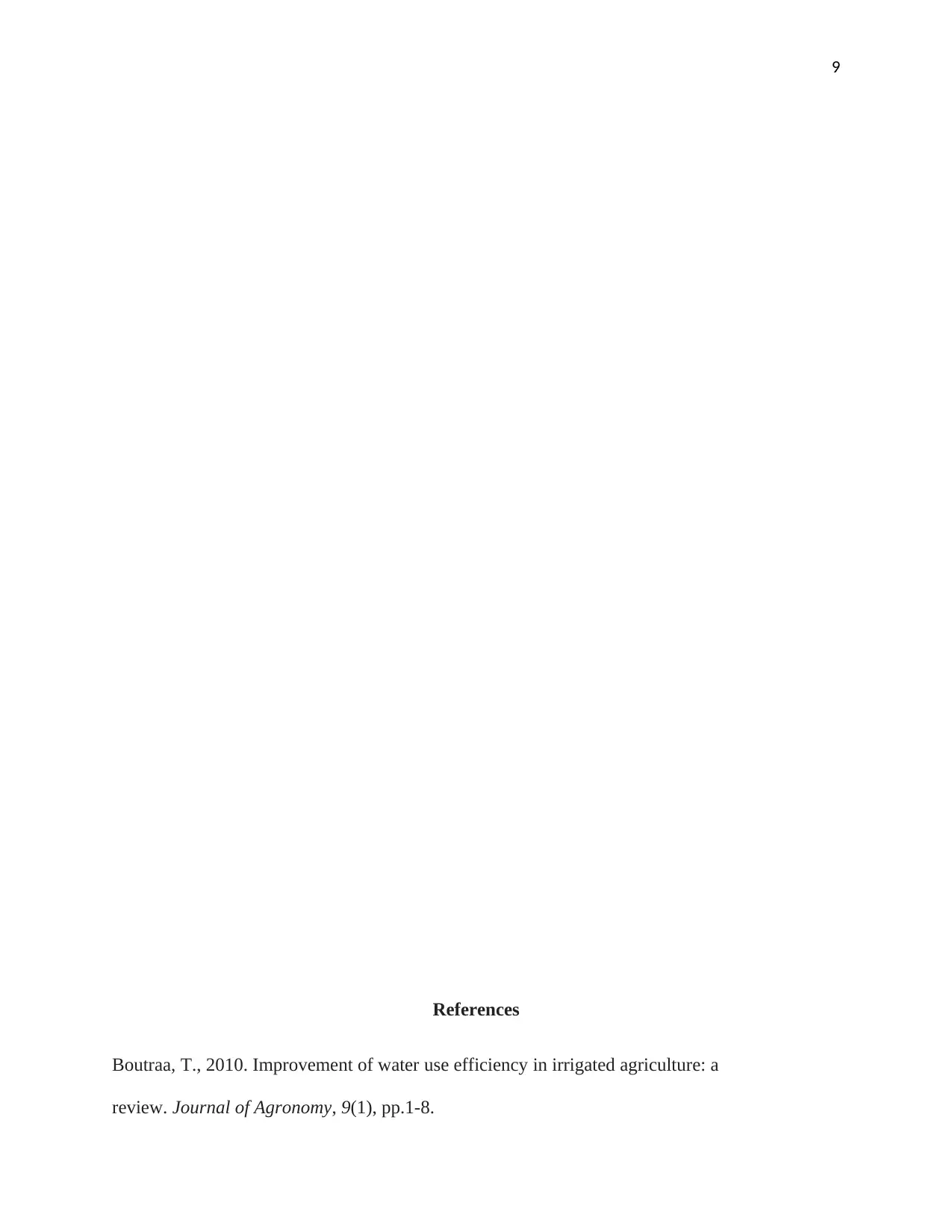
9
References
Boutraa, T., 2010. Improvement of water use efficiency in irrigated agriculture: a
review. Journal of Agronomy, 9(1), pp.1-8.
References
Boutraa, T., 2010. Improvement of water use efficiency in irrigated agriculture: a
review. Journal of Agronomy, 9(1), pp.1-8.
⊘ This is a preview!⊘
Do you want full access?
Subscribe today to unlock all pages.

Trusted by 1+ million students worldwide
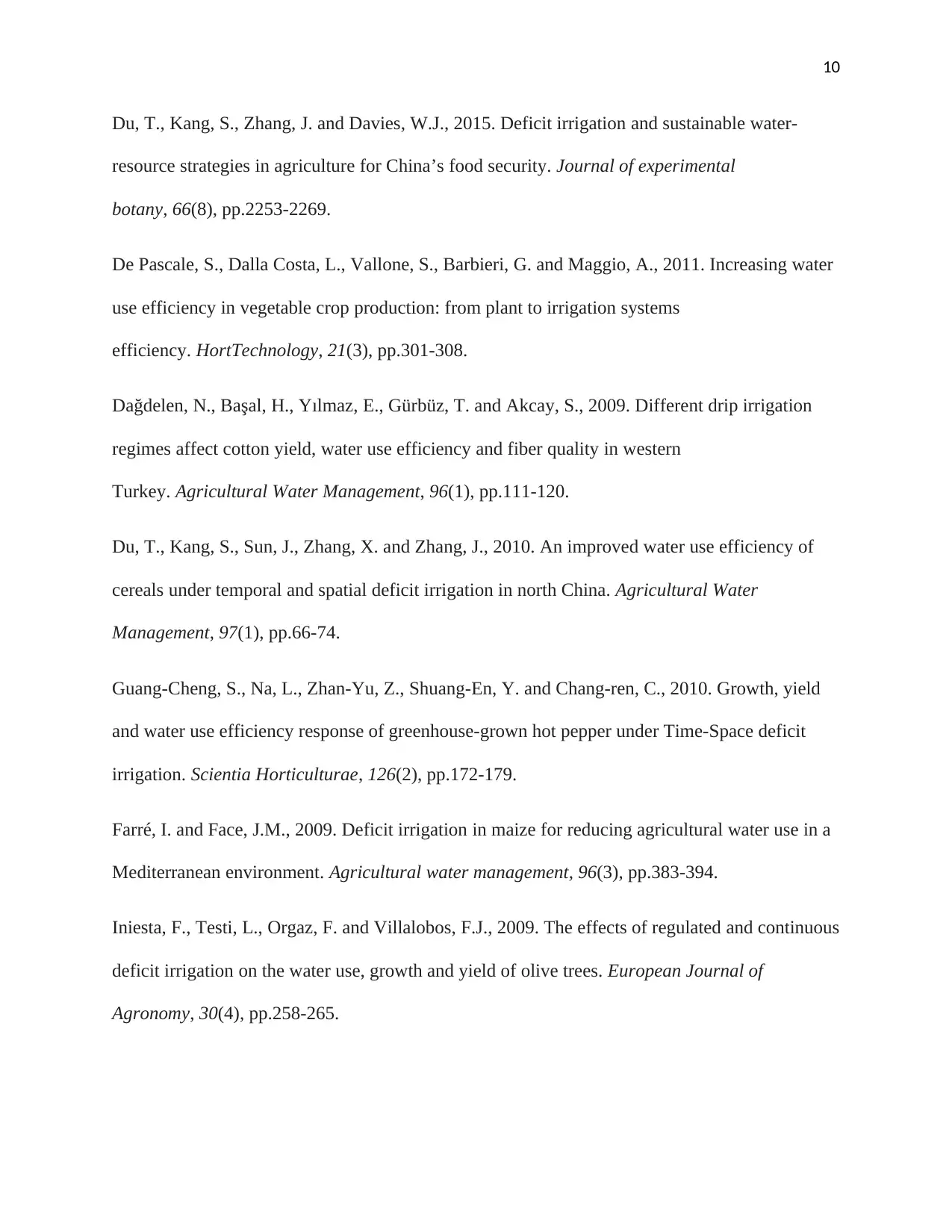
10
Du, T., Kang, S., Zhang, J. and Davies, W.J., 2015. Deficit irrigation and sustainable water-
resource strategies in agriculture for China’s food security. Journal of experimental
botany, 66(8), pp.2253-2269.
De Pascale, S., Dalla Costa, L., Vallone, S., Barbieri, G. and Maggio, A., 2011. Increasing water
use efficiency in vegetable crop production: from plant to irrigation systems
efficiency. HortTechnology, 21(3), pp.301-308.
Dağdelen, N., Başal, H., Yılmaz, E., Gürbüz, T. and Akcay, S., 2009. Different drip irrigation
regimes affect cotton yield, water use efficiency and fiber quality in western
Turkey. Agricultural Water Management, 96(1), pp.111-120.
Du, T., Kang, S., Sun, J., Zhang, X. and Zhang, J., 2010. An improved water use efficiency of
cereals under temporal and spatial deficit irrigation in north China. Agricultural Water
Management, 97(1), pp.66-74.
Guang-Cheng, S., Na, L., Zhan-Yu, Z., Shuang-En, Y. and Chang-ren, C., 2010. Growth, yield
and water use efficiency response of greenhouse-grown hot pepper under Time-Space deficit
irrigation. Scientia Horticulturae, 126(2), pp.172-179.
Farré, I. and Face, J.M., 2009. Deficit irrigation in maize for reducing agricultural water use in a
Mediterranean environment. Agricultural water management, 96(3), pp.383-394.
Iniesta, F., Testi, L., Orgaz, F. and Villalobos, F.J., 2009. The effects of regulated and continuous
deficit irrigation on the water use, growth and yield of olive trees. European Journal of
Agronomy, 30(4), pp.258-265.
Du, T., Kang, S., Zhang, J. and Davies, W.J., 2015. Deficit irrigation and sustainable water-
resource strategies in agriculture for China’s food security. Journal of experimental
botany, 66(8), pp.2253-2269.
De Pascale, S., Dalla Costa, L., Vallone, S., Barbieri, G. and Maggio, A., 2011. Increasing water
use efficiency in vegetable crop production: from plant to irrigation systems
efficiency. HortTechnology, 21(3), pp.301-308.
Dağdelen, N., Başal, H., Yılmaz, E., Gürbüz, T. and Akcay, S., 2009. Different drip irrigation
regimes affect cotton yield, water use efficiency and fiber quality in western
Turkey. Agricultural Water Management, 96(1), pp.111-120.
Du, T., Kang, S., Sun, J., Zhang, X. and Zhang, J., 2010. An improved water use efficiency of
cereals under temporal and spatial deficit irrigation in north China. Agricultural Water
Management, 97(1), pp.66-74.
Guang-Cheng, S., Na, L., Zhan-Yu, Z., Shuang-En, Y. and Chang-ren, C., 2010. Growth, yield
and water use efficiency response of greenhouse-grown hot pepper under Time-Space deficit
irrigation. Scientia Horticulturae, 126(2), pp.172-179.
Farré, I. and Face, J.M., 2009. Deficit irrigation in maize for reducing agricultural water use in a
Mediterranean environment. Agricultural water management, 96(3), pp.383-394.
Iniesta, F., Testi, L., Orgaz, F. and Villalobos, F.J., 2009. The effects of regulated and continuous
deficit irrigation on the water use, growth and yield of olive trees. European Journal of
Agronomy, 30(4), pp.258-265.
Paraphrase This Document
Need a fresh take? Get an instant paraphrase of this document with our AI Paraphraser
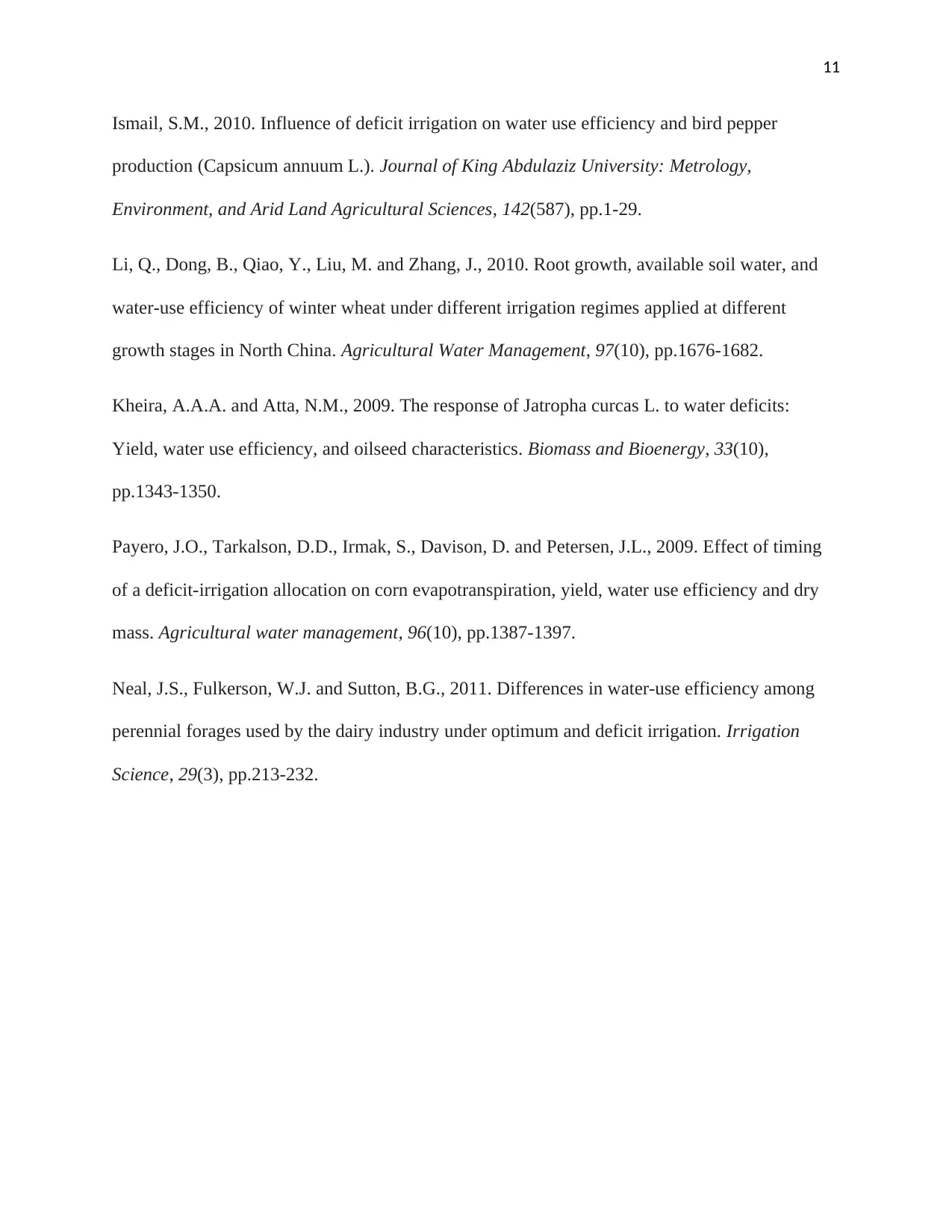
11
Ismail, S.M., 2010. Influence of deficit irrigation on water use efficiency and bird pepper
production (Capsicum annuum L.). Journal of King Abdulaziz University: Metrology,
Environment, and Arid Land Agricultural Sciences, 142(587), pp.1-29.
Li, Q., Dong, B., Qiao, Y., Liu, M. and Zhang, J., 2010. Root growth, available soil water, and
water-use efficiency of winter wheat under different irrigation regimes applied at different
growth stages in North China. Agricultural Water Management, 97(10), pp.1676-1682.
Kheira, A.A.A. and Atta, N.M., 2009. The response of Jatropha curcas L. to water deficits:
Yield, water use efficiency, and oilseed characteristics. Biomass and Bioenergy, 33(10),
pp.1343-1350.
Payero, J.O., Tarkalson, D.D., Irmak, S., Davison, D. and Petersen, J.L., 2009. Effect of timing
of a deficit-irrigation allocation on corn evapotranspiration, yield, water use efficiency and dry
mass. Agricultural water management, 96(10), pp.1387-1397.
Neal, J.S., Fulkerson, W.J. and Sutton, B.G., 2011. Differences in water-use efficiency among
perennial forages used by the dairy industry under optimum and deficit irrigation. Irrigation
Science, 29(3), pp.213-232.
Ismail, S.M., 2010. Influence of deficit irrigation on water use efficiency and bird pepper
production (Capsicum annuum L.). Journal of King Abdulaziz University: Metrology,
Environment, and Arid Land Agricultural Sciences, 142(587), pp.1-29.
Li, Q., Dong, B., Qiao, Y., Liu, M. and Zhang, J., 2010. Root growth, available soil water, and
water-use efficiency of winter wheat under different irrigation regimes applied at different
growth stages in North China. Agricultural Water Management, 97(10), pp.1676-1682.
Kheira, A.A.A. and Atta, N.M., 2009. The response of Jatropha curcas L. to water deficits:
Yield, water use efficiency, and oilseed characteristics. Biomass and Bioenergy, 33(10),
pp.1343-1350.
Payero, J.O., Tarkalson, D.D., Irmak, S., Davison, D. and Petersen, J.L., 2009. Effect of timing
of a deficit-irrigation allocation on corn evapotranspiration, yield, water use efficiency and dry
mass. Agricultural water management, 96(10), pp.1387-1397.
Neal, J.S., Fulkerson, W.J. and Sutton, B.G., 2011. Differences in water-use efficiency among
perennial forages used by the dairy industry under optimum and deficit irrigation. Irrigation
Science, 29(3), pp.213-232.
1 out of 11
Your All-in-One AI-Powered Toolkit for Academic Success.
+13062052269
info@desklib.com
Available 24*7 on WhatsApp / Email
![[object Object]](/_next/static/media/star-bottom.7253800d.svg)
Unlock your academic potential
Copyright © 2020–2025 A2Z Services. All Rights Reserved. Developed and managed by ZUCOL.